By Albert Cizauskas
Apostle of the Alleghenies
The first Catholic priest ordained in the United States , who received all his training here, was descended from one of Lithuania’s greatest rulers, Gediminas. Truth is stranger than , fiction and seldom was this more evident than in the life of Father Demetrius Augustine Gallitzin. Bom into a princely family, he renounced the pomp and splendor ofczarist court life to become a pioneer missionary to the settlers in the wilderness of western Pennsylvania.
The Early Years
he future priest was born on December 22, 1770 at The Hague where his father, Prince Dmitri Alexeievitch Golitsyn, was accredited as Russia’s Ambassador to Holland. In his forties, Prince Golitsyn was a bachelor when he happened to meet a beautiful young German countess at a fashionable spa where marriageable ladies went to find husbands and married ladies to find paramours. Prince Golitsyn was so enchanted that he proposed marriage shortly after their first meeting. Needless to say, Amelia’s family was delighted with such an auspicious match and the two were married with little loss of time at the spa.
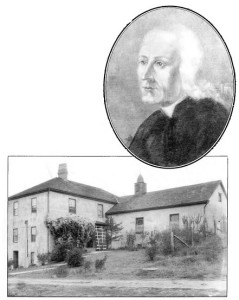
eight years before his death. Today the chapel is a public shrine and is open to visitors. Among the treasures it contains are the Prince’s altar encased in stone, his chalice, his ancient crucifix carved in wood, his parish record book, a beautiful clock with the date of 1760, sent to him from Germany by his mother, and many other personal mementos.
The marriage however proved to be a strange affair. The Prince and Countess lived together barely six years. After the birth of a son, Demetrius (“Mitri”), Amelia decided to forgo the world of courtly pleasure including the company of her husband. Prince Golitsyn concurred but retained conjugal rights, visiting Amelia from time to time as a result of which a daughter was born. As to the troublesome chore of rearing the children, the father gave this over to the mother for the time being. Their hasty marriage, brief life together and much longer life apart, punctuated with occasional visits of the father, would make an intriguing case history for a Freudian psychologist.
Amelia intended to educate her children shielded from the moral laxity of the Russian court. In pursuit of her objective, she took up residence in a humble cottage where she posted a sign, “NOT AT HOME,” and shaved off her long, flowing hair replacing it with a plain black wig.
The Education of a Prince
Unfortunately for Demetrius, Amelia was undergoing a course of self-education, trying to find, in today’s jargon, “where she was coming from.” In the process, she experim ented with various theories fashionable in the so-called Age of Reason. From being pampered, Demetrius would be suddenly thrust into the severest of regimens, forced to sleep alone at night in the dark, and awakened early in the morning with the application of a birch rod if necessary and then immersed in a cold water bath. With all the good intentions in the world, his mother harried and hounded him, exaggerating the smallest fault and berating him constantly. He confessed that, even as a young man, he could barely clear his throat or blow his nose without being obliged to listen to a long sermon about it. As a result, Demetrius, not surprisingly, showed signs of indecisiveness and timidity.
When he was ten, his mother felt it was time for more formal training. After a number of false starts, she was directed to the educational reforms introduced in Germany. Here Demetrius studied French, mathematics, music, riding and fencing, enough to get by in the limited world of courtly life. As to religion, she insisted that no attempt be made to convert her son. Demetrius’ father was content with this arrangement so long as it was understood that eventually his son would assume his rightful place in Russian society.
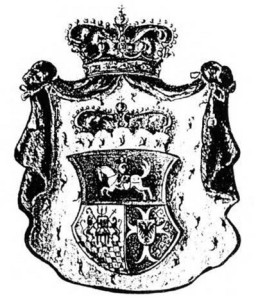
shows its Lithuanian origin. The galloping
Vytis — emblem of the Lithuanian state — is portrayed in the top section of the shield.
The crowns denote the family’s royal
ancestry. Father Demetrius is believed to have been the first to bring the Lithuanian national emblem to America.
But God w rites straight in crooked lines. Certainly no one could have foreseen what lay in store for the indecisive young man. After some time, Amelia became interested in the Catholic Church in which she had been baptized. In this, as in most matters, she influenced her children. By the time Demetrius was 17, Amelia and her two children became practicing Catholics. As with everything else, Catholicism now absorbed her entire attention but this time the novelty did not wear off. In fact, Amelia became a leader of the German Catholic Revival. Her husband viewed all this with indifference, regarding the adoption of Catholicism as a temporary aberration which his son would abandon once he ventured into his father’s world.
By the time Demetrius was in his early twenties, his father thought it time for his son to break the hold Amelia had on him. Fearing to expose her son to the moral corruption of the Russian court, she tried to delay the inevitable. In desperation, she sought her husband’s permission to send their son to America for a visit using the excuse that Demetrius needed time to mature. The father reluctantly gave his consent but set a time limit of two years. He admonished his son to study the language, laws and customs of the new and thriving Republic, and, above all, to become acquainted with Washington and Jefferson, both of whom he much admired. Amelia, on the other hand, secured Demetrius’ introduction to John Carroll of Baltimore, America’s first Bishop.
Surprise Vocation
Demetrius arrived in America in 1792 when he was 22 years old. The first thing he did was to make himself known to the small but active Catholic community in Baltimore. He immediately perceived that, contrary to what his mother envisaged, Bishop Carroll was as poor as the proverbial church mouse. Nor was he a spiritual lord in the European style, exercising temporal power in the America of that day.
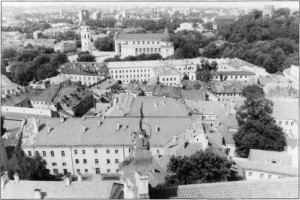
The poverty of the American Catholic Church was immaterial to the young Demetrius who had been taught by his mother to despise the goods of this world. Within two months of his arrival, he wrote home the startling news that he intended to become, not only a priest, but also a missionary to care for the spiritual needs of a rapidly expanding population pushing westward. He was fully alive to the hardships he would encounter, but a new firmness stiffened his hitherto timid personality away from his mother’s dominance.
Amelia had gambled and lost so unexpectedly. Despite her own renunciation of worldly honors and pleasures, she had clung to the notion that her son, a Prince of the Russian empire, would occupy a high position in the very society she had spurned for herself. Besides, she wanted him to be near so that she could continue to be his mother.
Demetrius was ordained in March of 1795, the first priest who had received all his training in this country. When his father received the news, he viewed it with a considerable measure of understanding, far more than Amelia had demonstrated. Dmitri senior understood that the sincerity of his son’s vocation lay in his decision to become a missionary on the American frontier which would entail a hard life not conducive to clerical preferment. He wrote to his wife that in Demetrius “Still waters run deep… He always wanted to go against wind and tide.”
On the other hand, Amelia wrote tearful entreaties to the rector of Demetrius’ seminary about her son’s imagined faults in the hope that he would be dismissed and return to her. The father was nearer the mark than the mother. Demetrius was so consumed with zeal for his vocation that the rector was often obliged to remove the night lamp to compel the seminarian to sleep.
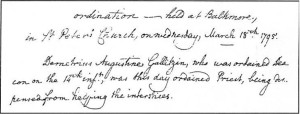
Pioneer Missionary
After several years as pastor to German communities in Maryland, Father Gallitzin was finally permitted to serve on the frontier. In 1799, the descendent of Gediminas set out for the virginal w ilderness of western Pennsylvania, a land so untamed that it was occasionally ravaged by Indians. There he founded a small Catholic outpost near the presentday cities of Johnstown and A ltoona. He p u rchased a large tract of land with money from his mother which he subdivided on easy terms to attract Catholic settlers. He called the place “Loretto” after a wellknown Marian shrine in Italy.
A log chapel was quickly hewn out of the trees in time for Christmas Eve, 1799- Where just a few months ago had stood a primeval forest, a Prince of this world celebrated, in the waning hours of the 18th century, the birth of a Prince of another world. Bedecked with holly and evergreens, and flickering in the light of many candles, the log chapel witnessed the birth of Catholicism on the Pennsylvania frontier.
The ” Apostle of the Alleghenies”
Despite an unpromising youth, Demetrius became eminently successful, both as a missionary and as an articulate defender of the early American Catholic Church. Demetrius Gallitzin tilted at the windmills of human frailty like his favorite literary figure, Don Quixote, but, unlike the Don, the priest missionary achieved a large measure of success. The “Apostle of the Alleghenies”, as he came to be called, left behind a thriving Church in what once had been a wilderness. His settlement at Loretto was like the mustard seed from which other missionaries branched out, making this corner of Pennsylvania a Catholic enclave in a Protestant region.
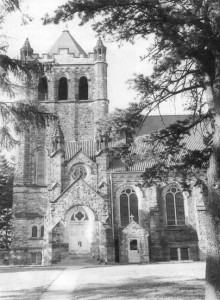
At the time of his death in 1840, there were over 10,000 Catholics in a district where there had been barely a dozen at the time of his arrival. In fact, the grow th of the Church population in the Loretto region eclipsed that of the American population as a whole, which rose from 5 million at the turn of the 19th century to 17 million forty years later.
“Something National and Catholic”
One of Gallitzin’s major contributions to the early Church in this country was the promulgation of a blend of Americanism and Catholicism at a time when adherents of the “Roman Church were barely tolerated. Earlier than most of his contemporaries, Gallitzin envisaged the evolution of a Catholicism in harmony with and supporting the Constitution, but without, in his apt phrase, overstraining the one or negating the other.” This native brand of apologetic preaching helped clear the way for Roman Catholicism to be accepted into the mainstream of American society.
Gallitzin was also one of the first to perceive the injustice of the double taxation imposed on Catholic parents when they sent their children to Catholic schools. He had been accustomed to the European custom of state support for all dulyqualified schools, including those administered by religious denominations. He fought, albeit unsuccessfully, for a similar dispensation in this country.
Among the articulate missionary’s pet peeves was the Protestant-sponsored tem perance movement which was beginning to attract Catholics. Gallitzin reasoned that there was no need to delegate to the Protestants a discipline implicit in the Catholic Church’s everyday teaching.
The “Apostle of the Alleghenies” left behind a thriving Church in what once had been a wilderness.
Gallitzin achieved no-little acclaim as a philosopher-apologist of the frontier. He enjoyed argumentation, and wrote extensively, upholding the Catholic faith against the knownothing onslaughts of rural Protestant fundamentalists. Among his works is A Defense of Catholic Principles, which he wrote in 1816.
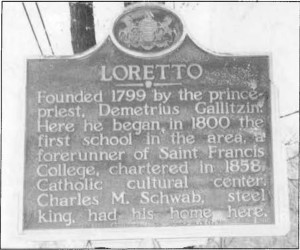
Toward the end of his illustrious career, Gallitzin was considered for several episcopal posts, including those at Pittsburgh and Cincinnati. It was partly due to his wish to remain with his flock, and partly to a recognition by the American hierarchy that Gallitzin was, at times, impractical, imprudent and over-bearing that he did not become a Bishop. He did, however, serve as Vicar-General for western Pennsylvania, an important administrative assignment.
By Their Fruits You Shall Know Them
Certainly, Gallitzin’s labor bore fruit a hundredfold. In recognition thereof, the Loretto area today boasts of many memorials to this intrepid missionary, including the 6,000-acre Prince Gallitzin State Park situated in the Allegheny Mountains. The nearby city of Gallitzin was also named in his honor.
There are few countries, with comparably small populations, whose sons have played such important roles in the history of other nations as Lithuania. The Gallitzins are a good example of this phenomenon.
We would like to express our sincere thanks to the Prince G allitzin H istorical Society o f Loretto, P ennsylvania and the Gallitzin Public Library for providing us the pictorial material used in this article.
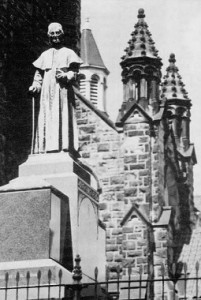
History of the Gallitzins
Rev. Demetrius Augustine Gallitzin was a direct de scendant of Norimantas (Narimundus), the second of seven sons of King Gediminas of Lithuania (1316-1341). Gediminas ruled his vast empire by dividing it among his sons. Norimantas was made Duke of Great Novgorod (in the region of present-day St. Petersburg). But he was unhappy there. After three years, he left the rule of the Duchy to his son Alexander and returned to Lithuania. Gediminas gave him the Duchies of Pinsk and Turov. From here Norimantas led his army in a campaign against the Teutonic Knights, during which he drowned in a river. After Norimantas’ death in 1348, his lands were divided between his sons, and Patrikis, the next ancestor of the Gallitzins, became Duke of Starodub, located east of the Dnieper River and south of Smolensk.
When some provinces in the east, among them Starodub, rebelled against the rule of Lithuanian king Vytautas, his brother Žygimantas was dispatched to take them over. Patrikis’ son George moved to Moscow where he married a distant relative, Maria, daughter of the Grand Duke Vasilii I of Moscow and granddaughter of Vytautas, thus originating the Gallitzins in Russia.
The first progeny of Prince George Pcitrikeyev (son of Patrikis) to make history was Prince Mikhail Pcitrikeyev Bulgakov-Golitza (Golica), a direct ancestor of Rev. Demetrius A. Gallitzin. In 1514 he led the Russian army against his former fatherland, but after initial successes was totally defeated at the Battle of Orsha by the Lithuanians. He was taken captive and held for 38 years in Vilnius. After his return to Russia he entered a monastery where he spent his remaining years. The nickname Golitz, meaning “gauntlet”, thus became synonymous with military bravery, and his descendants assumed Golitsyn as their surname. The name was westernized to Gallitzin when the father of Rev. Demetrius became Ambassador to Paris.
As the descendants of kings, the Golitsyns always possessed great influence and prestige. One Golitsyn almost became Czar in the early part of the 17th century. He died in the Lithuanian city of Gardinas (Grodno) and was buried in Vilnius. His brother Andrey had four sons. This branch of the family, known in Russian history as the Great Golitsyns, included great statesmen, prominent diplomats and highly educated humanists of Western European culture. The line also included military leaders, scientists, writers, historians, and a famous Catholic missionary, Mother Elizabeth Gallitzin. In 1839 she was sent to the United States and Canada where she founded convents. She died while nursing those struck with yellow fever in Louisiana.
Our Demetrius A. Gallitzin comes from the branch of Alexis, one of the sons of Andrey Golitsyn. Alexis had two sons, Boris and Ivan. Not much is known about Ivan nor about his son Alexei, who died at age 32, leaving only one child, Prince Dmitri Alexievitch Golitsyn, the father of Rev. Demetrius Augustine Gallitzin.
 DRAUGAS NEWS Lithuanian World Wide News in English
DRAUGAS NEWS Lithuanian World Wide News in English
